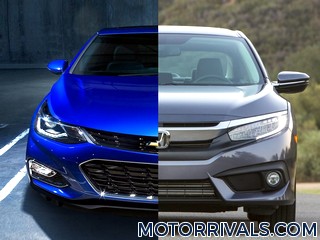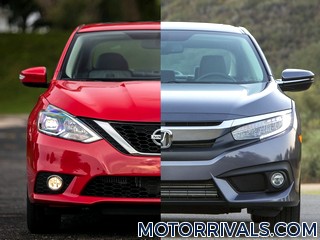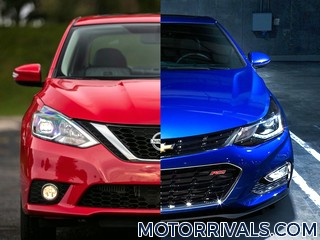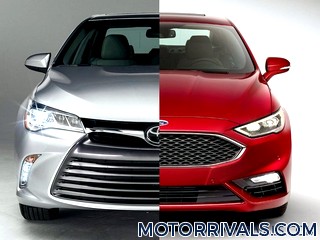2017 Mazda 3 vs 2017 Honda Civic
Mazda Press Release Highlights
Building on its award-winning predecessor, developers of the all-new Mazda 3 set out to do no less than come up with a car that actually interacts with its owner on several levels. On the surface, it's a top quality means of transport, delivering an unmatched combination of performance, fuel efficiency and functionality in a package that's as safe and practical as it is stunning. Here it follows in the footprints of its new generation forerunners: the Mazda CX-5, a compact SUV that drives like a car, and the new Mazda 6, which more recently took the mid-sized class by storm.
Powertrain
The new Mazda 3 also comes with the SKYACTIV-G 2.0 in two versions. The high-power version churns out 121kW / 165PS at 6,000rpm and 210Nm at 4,000rpm. It thrusts the compact from a standstill to 100km/h in 8.2 seconds with a terminal speed of 210km/h. At 5.8l/100km and 135g/km, fuel consumption and CO2 emissions are very respectable for such performance. The standard power SKYACTIV-G 2.0, meanwhile, puts out 88kW / 120PS at 6,000rpm and, like its sibling, 210Nm at 4,000rpm. Available for both body styles with either the SKYACTIV-Drive automatic or SKYACTIV-MT manual transmission, this economical option combines first-rate fuel efficiency and CO2 emissions - 5.1l/100 km and 119g/km (manual) and 5.6l/100 km and 128g/km (automatic) - with respective sprint times of 8.8 and 10.3 seconds, topping out at 198km/h.The SKYACTIV-D clean diesel also uses extreme compression and lightweight design as the basis for powerful yet remarkably fuel-efficient engines. Unusually for a diesel, the 380Nm of maximum torque at 1,800rpm and 110kW / 150PS at 4,500rpm offers satisfying pull from a standstill through to its 5,500rpm redline. The new Mazda 3 takes only 8.0 seconds to reach 100km/h with a manual and 9.7 seconds for the automatic (hatchback only), with respective top speeds of 213km/h and 201km/h. And that with fuel economy and CO2 emissions of 3.9l/100km and 104g/km (sedan with manual), and 4.8l/100 km and 127g/km (hatchback with automatic).
Chassis
Mazda tuned the new Mazda 3's SKYACTIV-Chassis to respond more faithfully than ever to driver intentions. High-tensile steel (780MPa) was used for the lower suspension arms on the front MacPherson struts and rear multi-link trailing arms. This not only makes the suspension lighter, but also smoothens load transfers and with it changes in cornering g-forces. The positioning of rear suspension links and hardness of the bushings, meanwhile, improves the lateral grip of the rear tires. By moving the trailing arm position forward, the dampers can better absorb road influences.The electric power assist steering's lower gear ratio - 14:1 versus 16.2:1 on the current model - means less steering wheel movement, enhancing agility and helping avoid driver fatigue, particularly on winding roads and in the city. The system is smaller, lighter and more energy efficient, too. The brakes get smaller cylinders, retuned boosters and reduced pedal play to suppress motion resistance. These improve brake control, responsiveness and fuel economy. In combination with new high-grip tires, they're particularly effective on wet roads: Stopping distances are considerably shorter than the current model and among the best in the segment.
Technology
The in-vehicle system expands on features already available in Mazdas, like Bluetooth®, email, SMS and navigation, adding a whole new scale of connected convenience. Using a smartphone connected to the Mazda 3 system via Bluetooth® or USB, Mazda 3 occupants have safe and easy real-time access via the 7-inch display to infotainment services from Aha. It offers a wide and growing range of mobile infotainment content and social media services, including tens of thousands of internet radio stations, Twitter and Facebook feeds, news, audio books and more.Aha is a cloud-based automotive grade internet connectivity platform. Available for the first time at Mazda with the all-new Mazda 3, Aha is designed to provide a single integration point bringing a wide range of free web-based infotainment content safely into the vehicle. Aha lets the user access and organize their favorite web content on their phone, then seamlessly integrates the experience in their car. Developed together with BOSE® especially for the new Mazda 3, the new 9-speaker BOSE® premium sound system features the latest in playback technology and, of course, plenty of power.
Safety
i-ACTIVSENSE is Mazda's term for its advanced range of sensor-based and radar-supported safety technology. The radar-based Rear Vehicle Monitoring system (RVM), for example, tells the driver when vehicles are approaching the new Mazda 3 from behind in adjacent lanes - including the blind spots - by activating an LED in the corresponding side mirror. The Lane Departure Warning System (LDWS), meanwhile, watches the lane markings at 65km/h and higher, alerting the driver with audible (rumble strip sound) and visual warnings should it detect unplanned lane changes. And the Distance Recognition Support System (DRSS) looks well ahead of the car, calculating and displaying the proximity and catch-up time to preceding vehicles at 30-200km/h. The Adaptive Front-lighting System (AFS) predicts the shape of the curve ahead based on steering input and speed, turning the headlamps in the right direction. Hill Launch Assist (HLA) is another helpful system that maintains brake pressure to prevent rolling during hill starts. i-ACTIVSENSE pre-crash safety technology warn the driver of potential danger. However, as names like Mazda Radar Cruise Control (MRCC) and Smart Brake Support (SBS) suggest, they'll also take evasive action if necessary to avoid an accident or limit the damage. Naturally, the new Mazda 3 also has standard ABS with electronic brakeforce distribution (EBD) and brake assist (EBA) as well as dynamic stability control (DSC) and traction control (TCS).Honda Press Release Highlights
Virtually everything about the 2016 Civic Sedan is new – an all-new vehicle architecture, sporty and sophisticated new interior and exterior styling, a more spacious and high-quality cabin, two advanced new engines, and a host of new premium features and technologies.
Further, with the addition of Honda Sensing™ safety and driver-assistive technologies and the first application of Honda turbo engine technology to Civic, the 2016 Civic Sedan offers buyers a wider range of options than ever before. Civic models powered by the new 2.0-liter i-VTEC™ engine are designated as the Civic LX and EX trims. Civic models powered by the new turbocharged 1.5-liter engine are designated as the EX-T, EX-L (with leather-trimmed interior) and new line-topping Civic Touring, which reaches higher into the upper end of the compact car market than ever before.
Powertrain
Powering the 2016 Civic Sedan are two all-new engines, both designed to provide highly refined, responsive and fuel-efficient performance. Civic Sedans in LX and EX trim are powered by a 2.0-liter DOHC, 16-valve, port-injected, inline 4-cylinder engine with i-VTEC™ valvetrain producing a peak 158 hp at 6,500 rpm and 138 lb-ft. of torque at 4,200 rpm, making it the most powerful base engine ever offered in Civic. The new 2.0-liter engine is mated to a sporty continuously variable transmission (CVT) with Honda G-Design shift control, or a quick-shifting 6-speed manual transmission.
Civic Sedans in EX-T, EX-L and Touring trim are powered by an all-new turbocharged 1.5-liter DOHC, direct-injected and inline 4-cylinder engine with variable cam timing (VTC) and electronic waste gate, turning out 174 hp at 5,500 rpm and peak torque of 162 lb-ft. from 1,800 to 5,500 rpm. The 1.5-liter turbo engine is mated to a new CVT that combines with the low-inertia turbo, VTC and electronic waste gate to optimize power delivery across the engine's full operating range.
Both engines feature a wide array of friction-reduction design and engineering features that support both high performance and high fuel efficiency. These two ultra-efficient engines, married to the 2016 Civic's light, rigid and highly aerodynamic body, help the Civic garner anticipated class-leading EPA-estimated fuel economy ratings of 31/41/35 mpg (city/highway/combined)1 for the 2.0-liter engine with CVT and 31/42/35 mpg1 for the 1.5-liter turbo with CVT.
Chassis
- Ultra-rigid body with
59-percent application of high-strength steel and 14-percent application
of ultra-high-strength steel (up from 55 percent and 1 percent,
respectively, in the previous model) – the most extensive use of
high-tensile steel ever in a Civic
- 68-pound reduction in unibody
weight versus the previous Civic Sedan, despite its larger size and
greater stiffness
- ACE™ body structure with new crash stroke design
(Honda and Civic first) for improved collision performance in a
sportier, more compact front frame design
- Ultra-high-strength steel
B-pillars and rear frame rails with selectively-tempered "soft zones"
for reduced weight and enhanced collision performance (Civic first)
- Ultra-rigid 590-mpa high-strength-steel floor for enhanced collision performance and improved ride quality (Civic first)
- New multi-link independent rear suspension
- Hydraulic
compliance bushings for premium levels of ride quality and road
vibration isolation (Civic first)
- Larger stabilizer bars with bonded
bushings for more refined body control (Civic first)
- Rigid aluminum
rear damper brackets for improved ride quality (Civic first)
- Agile
Handling Assist brake torque vectoring for cornering precision and
stability (Civic first)
- Dual-pinion electric power steering with variable gear ratio for improved steering feel and maneuverability (Civic first)
Technology
- Remote Engine start
- Electronic parking brake
- Walk Away Door
Locking
- Dual-zone automatic climate control
- Rain-sensing wipers
- Display
Audio with Apple CarPlay® and Android Auto
- Raising intuitive operation and digital connectivity to the next level, the 2016 Civic Sedan in EX and above trims incorporates a new 7-inch Display Audio touchscreen that serves as the nerve center for control of audio, HVAC and other functions. The new Display Audio is integrated with new Apple CarPlay®3 and Android Auto2 platforms, providing seamless integration of smartphone features and functions, including app-based navigation, streaming audio, voice-controlled search capabilities, and access to a host of Apple- or Google-approved smartphone apps.
Safety
The Civic utilizes advanced front, side and side curtain airbag technology, including a driver's front airbag with new spiral stitching for an improved deployment profile; SmartVent® technology for the driver and front passenger side airbags; and a new front passenger airbag with safety vent technology that can mitigate the possibility of injury from airbag deployment when the passenger is "out of position." These systems work in conjunction with the advanced body structure and optimally tuned interior components to help mitigate injuries in a collision.




















